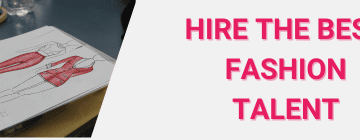In today’s fashion industry, data is not just for understanding customer preferences—it’s also a powerful tool for transforming the recruitment process. Leveraging data-driven strategies can help fashion brands make smarter hiring decisions, streamline recruitment efforts, and ultimately build a more effective and dynamic team. This blog explores how to harness the power of data to revolutionize fashion recruitment.
How Data-Driven Strategies Enhance Fashion Recruitment
1. Identifying Talent Gaps with Workforce Analytics
Understanding where your team lacks critical skills is the first step in targeted recruitment. By analyzing workforce data, you can identify talent gaps that need to be filled and predict future hiring needs. This proactive approach ensures that your recruitment efforts are focused on acquiring the skills that will drive your brand forward.
Key Approach: Use workforce analytics to map out the skills and experience of your current employees. Identify areas where your team may be lacking, such as digital marketing expertise, sustainability knowledge, or technical design skills. By pinpointing these gaps, you can tailor your recruitment strategy to find candidates who will complement and strengthen your existing team.
2. Enhancing Candidate Sourcing with Predictive Analytics
Predictive analytics can transform how you source candidates by identifying where your best hires are likely to come from. By analyzing past hiring data, you can determine which channels, job boards, or social media platforms are most effective for attracting top talent. This data-driven approach reduces time and resources spent on less effective recruitment channels.
Key Approach: Analyze historical hiring data to discover patterns in where your most successful employees were sourced. Use this information to focus your candidate sourcing efforts on platforms and networks that yield the best results, whether it’s LinkedIn, industry-specific job boards, or fashion design schools.
3. Streamlining the Screening Process with AI
Artificial intelligence (AI) can significantly reduce the time spent on screening candidates by automating the initial stages of the hiring process. AI tools can quickly sift through resumes, identify key qualifications, and even assess cultural fit based on predefined criteria. This allows your recruitment team to focus on the most promising candidates.
Key Approach: Implement AI-powered applicant tracking systems (ATS) that can automatically filter out unqualified candidates and rank applicants based on their suitability for the role. This streamlines the screening process and ensures that your team spends their time on candidates who are most likely to succeed.
4. Improving Diversity and Inclusion with Data-Driven Recruitment
Diversity and inclusion are critical in the fashion industry, but unconscious bias can often hinder these efforts. Data-driven recruitment strategies can help mitigate bias by focusing on objective metrics rather than subjective judgments. By analyzing data on candidate demographics and hiring patterns, you can identify and address any biases in your recruitment process.
Key Approach: Use data analytics to track diversity metrics across your hiring process, from the applicant pool to final hires. Implement tools that anonymize applications during the initial screening stages to reduce unconscious bias. This data-driven approach ensures that all candidates are judged solely on their skills and qualifications.
5. Optimizing Job Descriptions with Data Insights
Job descriptions are crucial in attracting the right candidates, but they often rely on intuition rather than data. By analyzing which job descriptions have historically attracted the best candidates, you can refine your language, keywords, and role requirements to improve future postings. Data can reveal what resonates most with top talent.
Key Approach: Analyze the performance of past job postings, looking at metrics like the number of qualified applicants, time-to-hire, and eventual employee performance. Use this data to tweak job descriptions, optimizing everything from the job title to the specific qualifications listed, ensuring that you’re attracting the best possible candidates.
6. Personalizing the Candidate Experience with Data
A personalized candidate experience can set your brand apart in a competitive job market. By using data to understand candidate behavior and preferences, you can tailor your communication, interview process, and job offers to align with what candidates value most. This personalization can lead to higher acceptance rates and a stronger employer brand.
Key Approach: Use data from candidate interactions—such as email engagement, application behavior, and interview feedback—to personalize the recruitment process. For example, if a candidate shows a strong preference for remote work, highlight your flexible work policies during the interview process. Personalization based on data can make your job offers more appealing and increase your chances of securing top talent.
7. Tracking Recruitment Metrics for Continuous Improvement
Finally, data allows you to measure the effectiveness of your recruitment strategies over time. By tracking key recruitment metrics—such as cost per hire, time to fill, and quality of hire—you can continuously refine your approach, making data-driven adjustments that enhance your overall recruitment efficiency.
Key Approach: Establish a set of key performance indicators (KPIs) for your recruitment process and regularly review these metrics to identify areas for improvement. Use this data to experiment with new strategies, such as different sourcing methods or interview techniques, and measure the impact of these changes on your recruitment outcomes.
Conclusion
Data-driven strategies offer a revolutionary approach to fashion recruitment, enabling brands to make smarter, more informed decisions throughout the hiring process. From identifying talent gaps and sourcing candidates to optimizing job descriptions and personalizing the candidate experience, data can enhance every aspect of recruitment. By embracing data analytics, AI, and predictive tools, fashion brands can not only reduce recruitment costs and time-to-hire but also ensure they are building teams that are well-equipped to thrive in a rapidly evolving industry.


